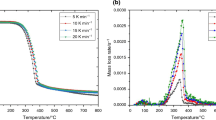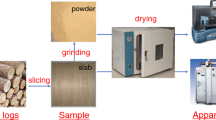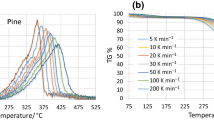Abstract
Engineered wood products (EWPs) are a group of materials having a very similar chemical composition but having different and non-uniform thermo-physical properties throughout their thickness. Such materials present a significant challenge from the pyrolysis modelling point of view. The main focus of the paper is to study and compare the differences between six EWPs—oriented strand board (OSB), plywood, particle board (PB), low-density (LDF), medium-density (MDF) and high-density (HDF) fibreboard—in terms of their pyrolysis and burning behaviour. Vertical density profiles (VDPs), thermal degradation behaviour, and burning behaviour were studied and compared. There is a considerable need for a consistent and systematic approach in estimating pyrolysis model complexity and model input parameters. A systematic method to determine the minimum level of the EWPs decomposition model complexity to reproduce the thermal degradation behaviour as measured using thermogravimetric analysis and using the set of parallel reactions was applied. EWPs were found to have similar thermal decomposition onset and range. Maximal decomposition rates were within 25%. OSB, PB, LDF and HDF decomposition can be modelled using three-step parallel reactions scheme, MDF using four parallel reactions. A set of parallel reactions cannot describe the thermal degradation behaviour of plywood. Cone calorimeter tests at heat flux levels of 20 kW/m2, 50 kW/m2 and \(80\, \hbox {kW}/\hbox {m}^{2}\) revealed that influence of the different thermo-physical properties on time to ignition and time to peak heat release rate (HRR) is not significant except LDF and HDF due to their very different density. Peak HRR varies between EWPs, which is attributed primarily to charring and different thermo-physical properties of the EWPs char. EWPs gas phase combustion parameters for the fire models were derived.









Similar content being viewed by others
Abbreviations
- A :
-
Pre-exponential factor (1/s)
- e :
-
Euler number (2.71828)
- E :
-
Activation energy (J/mol)
- \(\varDelta H_{c}\) :
-
Effective heat of combustion (MJ/kg)
- k :
-
The number of points in data set (–)
- L :
-
Thickness (mm)
- m :
-
Mass (mg)
- n :
-
Reaction order (–)
- N :
-
Total number of reactions (–)
- p :
-
Number of complexes (–)
- r :
-
Reaction rate (1/s)
- R :
-
Universal gas constant (8.314 J/mol/K)
- t :
-
Time (s)
- T :
-
Temperature (K)
- \(\varDelta T\) :
-
Pyrolysis range (K)
- y :
-
Mass fraction (–)
- \(\alpha\) :
-
Conversion (–)
- \(\beta\) :
-
Heating rate (K/s)
- \(\xi\) :
-
Mass loss change (1/s)
- \(\rho\) :
-
Density (\(\hbox {kg}/\hbox {m}^3\))
- \(\nu\) :
-
Stoichiometric coefficient (–)
- exp :
-
Experiment
- j :
-
Reaction
- p :
-
Peak
- R :
-
Residue
- X :
-
Component
- 0:
-
Initial state
- CFD:
-
Computational fluid dynamics
- DSC:
-
Differential scanning calorimetry
- DTG:
-
Derivative thermogravimetric
- DDTG:
-
Second derivative thermogravimetric
- EWP:
-
Engineered wood product
- FDS:
-
Fire dynamics simulator
- FV:
-
Fitness value
- HDF:
-
High-density fibreboard
- HRR:
-
Heat release rate
- LDF:
-
Low-density fibreboard
- MDF:
-
Medium-density fibreboard
- MLR:
-
Mass loss rate
- ODE:
-
Ordinary differential equation
- OSB:
-
Oriented strand board
- PB:
-
Particle board
- PTFE:
-
Polytetrafluoroethylene
- RSD:
-
Relative standard deviation
- SCE:
-
Shuffled complex evolution
- STA:
-
Simultaneous thermal analysis
- TGA:
-
Thermogravimetric analysis
- VDP:
-
Vertical density profile
References
Wong WCK, Dembsey NA, Alston J, Lautenberger C (2013) A multi-component dataset framework for validation of CFD flame spread models. J Fire Prot Eng 23(2):85–134
Kim ME, Dembsey N (2012) Engineering guide for estimating material pyrolysis properties for fire modeling. Technical report, Worcester Polytechnic Institute
Lautenberger C, Fernandez-Pello C (2011) Optimization algorithms for material pyrolysis property estimation. In: Fire safety science proceedings of the tenth international symposium, pp 751–764
Chaos M, Khan MM, Krishnamoorthy N, Ris JL, Dorofeev SB (2011) Evaluation of optimization schemes and determination of solid fuel properties for CFD fire models using the bench-scale pyrolysis tests. Proc Combust Inst 33:2599–2606
Stoliarov SI, Li J (2016) Parametrization and validation of pyrolysis models for polymeric materials. Fire Technol 52(1):79–91
Kim E, Dembsey N (2015) Parameter estimation for comprehensive pyrolysis modeling: guidance and critical observations. Fire Technol 51(2):443–477
McKinnon M (2016) A generalized methodology to characterize composite materials for pyrolysis models. PhD thesis, University of Maryland
Ge J, Wang R, Liu L (2016) Study on the thermal degradation kinetics of the common wooden boards. Proc Eng 135:72–82
Li KY, Fleischmann CM, Spearpoint MJ (2013) Determining thermal physical properties of pyrolyzing New Zealand medium density fibreboard (MDF). Chem Eng Sci 95:211–220
Li KY, Cheng X, Zhang H (2014) A simplified model on vertical density profile and shrinkage ratio of virgin and charred medium density fibreboard. Fire Mater 38:659–672
Huang X, Li K, Zhang H (2017) Modelling bench-scale fire on engineered wood: effects of transient flame and physicochemical properties. Proc Combust Inst 36:3167–3175
Zeinali D, Gupta A, Maragkos G, Agarwal G, Beji T, Chaos M, Wang Y, Degroote J, Merci B (2019) Study of the importance of non-uniform mass density in numerical simulations of fire spread over MDF panels in corner configuration. Combust Flame 200:303–315
Antal MJ (1998) Cellulose pyrolysis kinetics: revisited. Ind Eng Chem Res 37:1267–1275
Bal N, Rein G (2013) Relevant model complexity for non-charring polymer pyrolysis. Fire Saf J 61:36–44
Ghorbani Z, Webster R, Lázaro M, Trouvé A (2013) Limitations in the predictive capability of pyrolysis models based on a calibrated semi-empirical approach. Fire Saf J 61:274–288
Ma JF, Zhang QL (2008) Approximation property of T-S fuzzy singular systems. Control Theory Appl 25(5):837–844
Li K, Huang X, Fleischmann C, Rein G (2014) Pyrolysis of medium-density fiberboard:optimized search for kinetics scheme and parameters via a genetic algorithm driven by kissinger’s method. Energy Fuels 28:6130–6139
Stark NM, Cai Z, Carll C (2010) Wood-based composite materials. In: Ross RJ (ed) Wood handbook: wood as an engineering material. Forest Products Laboratory, United States Department of Agriculture Forest Service, Madison, Wisconsin
Narayan R, Antal MJ (1996) Thermal lag, fusion, and the compensation effect during biomass pyrolysis. Ind Eng Chem Res 35:1711–1721
Richter F, Rein G (2018) The role of heat transfer limitations in polymer pyrolysis at the microscale. Front Mech Eng 4:18
Richter F, Rein G (2019) Heterogeneous kinetics of timber charring at the microscale. J Anal Appl Pyrol 138:1–9
Back G, Beyler C, DiNenno P, Tatem P (1994) Wall incident heat flux distributions resulting from an adjacent fire. In: Fire safety science-proceedings of the fourth international symposium, pp 241–252. International Association for Fire Safety Science
Babrauskas V, Mulholland G (1987) Smoke and soot data determinations in the cone calorimeter. In: Mathematical modleing of fires, ASTM STP 983, pp 83–104. American Society for Testing and Materials
Matala A, Lautenberger C, Hostikka S (2012) Generalized direct method for pyrolysis kinetic parameter estimation and comparison to existing methods. J Fire Sci 30(4):339–356
Rein G, Lautenberger C, Fernandez-Pello C, Torero JL, Urban DL (2006) Application of genetic algorithms and thermogravimetry to determine the kinetics of polyurethane foam in smoldering combustion. Combust Flame 146:95–108
Lautenberger C, Rein G, Fernandez-Pello C (2006) The application of a genetic algorithm to estimate material properties for fire modeling from bench-scale fire test data. Fire Saf J 41:204–214
Lautenberger C, Fernandez-Pello C (2009) A model for the oxidative pyrolysis of wood. Combust Flame 156:1503–1513
Hasalová L, Ira J, Jahoda M (2016) Practical observations on the use of shuffled complex evolution (SCE) algorithm for kinetic parameters estimation in pyrolysis modeling. Fire Saf J 80:71–82
Li K, Pau DS, Zhang H (2016) Pyrolysis of polyurethane foam: optimized search for kinetic properties via simultaneous K–K method, genetic algorithm and elemental analysis. Fire Mater 40:800–817
Lyon RE, Safronova N, Oztekin E (2011) A simple method for determining kinetic parameters for materials in fire models. In: Fire safety science proceedings of the tenth international symposium, pp 765–778
McGrattan K, Hostikka S, Floyd J, Vanella M (2018) Fire dynamics simulator, technical reference guide: verification, vol 2. National Institute of Standards and Technology, Gaithesburg
Duan QY, Sorooshian S, Gupta VK (1993) Shuffled complex evolution approach for effective and efficient global minimization. J Optim Theory Appl 76:501–521
Duan Q, Sorooshian S, Gupta VK (1994) Optimal use of the sce-ua global optimization method for calibrating watershed models. J Hydrol 158:265–284
Grønli MG, Varhegyi G, Di-Blasi C (2002) Thermogravimetric analysis and devolatilization kinetics of wood. Ind Eng Chem Res 41:4201–4208
Yang H, Yan R, Chen H, Lee DH, Zheng C (2007) Characteristics of hemicellulose, cellulose and lignin pyrolysis. Fuel 86:1781–1788
Ding Y, Ezekoye OA, Lu S, Wang C, Zhou R (2017) Comparative pyrolysis behaviors and reaction mechanisms of hardwood and softwood. Energy Convers Manag 132:102–109
Fateh T, Rogazme T, Luche J, Jabouille F (2013) Kinetic and mechanism of the thermal degradation of a plywood by using thermogravimetry and fourier-transformed infrared spectroscopy analysis in nitrogen and air atmosphere. Fire Saf J 58:25–37
Richter F, Rein G (2017) Pyrolysis kinetics and multi-objective inverse modelling of cellulose at the microscale. Fire Saf J 91:191–199
Bal N, Rein G (2015) On the effect of inverse modelling and compensation effects in computational pyrolysis for fire scenarios. Fire Saf J 72:68–76
Patel P, Hull TR, Stec AA, Lyon RE (2011) Influence of physical properties on polymer flammability in the cone calorimeter. Polym Adv Technol 22:1100–1107
Matala A (2008) Estimation of solid phase reaction parameters for fire simulation. Master’s thesis, Helsinky University of Technology
Lautenberger C (2007) Generalized pyrolysis model for combustible solids. PhD thesis, University of California
Stoliarov SI, Safronava N, Lyon RE (2009) The effect of variation in polymer properties on the rate of burning. Fire Mater 33:257–271
Stoliarov SI, Crowley S, Walters RN, Lyon RE (2009) Prediction of the burning rates of charring polymers. Fire Mater 33:257–271
Li K, Mousavi M, Hostikka S (2017) Char cracking of medium density fibreboard due to thermal shock effect induced pyrolysis shrinkage. Fire Saf J 91:165–173
Ragland KW, Aerts DJ (1991) Properties of wood for combustion analysis. Bioresour Technol 37:161–168
Acknowledgements
The authors would like to acknowledge financial support from the Specific University Research (MSMT No 21-SVV/2018) fund of the Ministry of Education Youth and Sport of the Czech Republic. The authors would like to acknowledge financial support by the Czech Science Foundation (project GACR no. 19-22435S).
Author information
Authors and Affiliations
Corresponding author
Additional information
Publisher's Note
Springer Nature remains neutral with regard to jurisdictional claims in published maps and institutional affiliations.
Rights and permissions
About this article
Cite this article
Ira, J., Hasalová, L., Šálek, V. et al. Thermal Analysis and Cone Calorimeter Study of Engineered Wood with an Emphasis on Fire Modelling. Fire Technol 56, 1099–1132 (2020). https://doi.org/10.1007/s10694-019-00922-9
Received:
Accepted:
Published:
Issue Date:
DOI: https://doi.org/10.1007/s10694-019-00922-9




